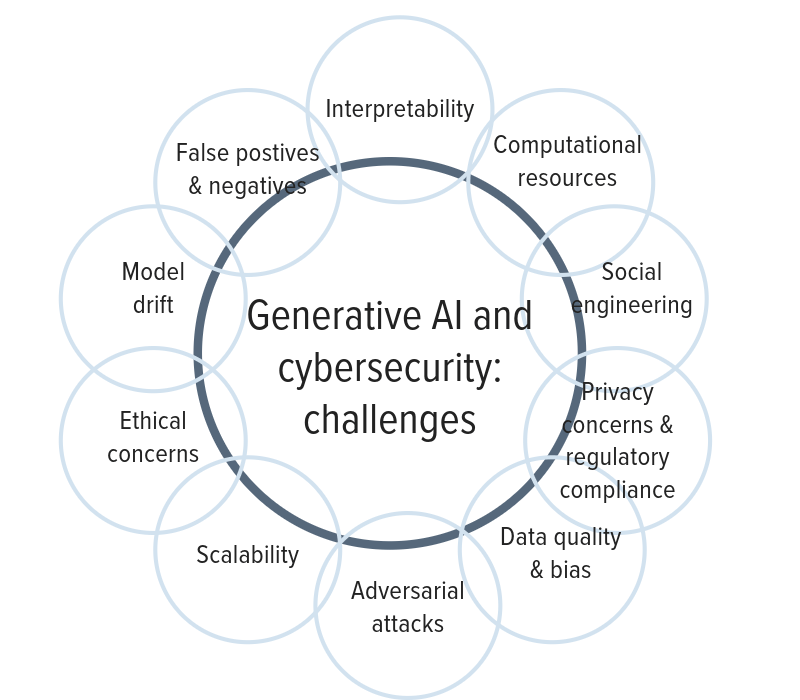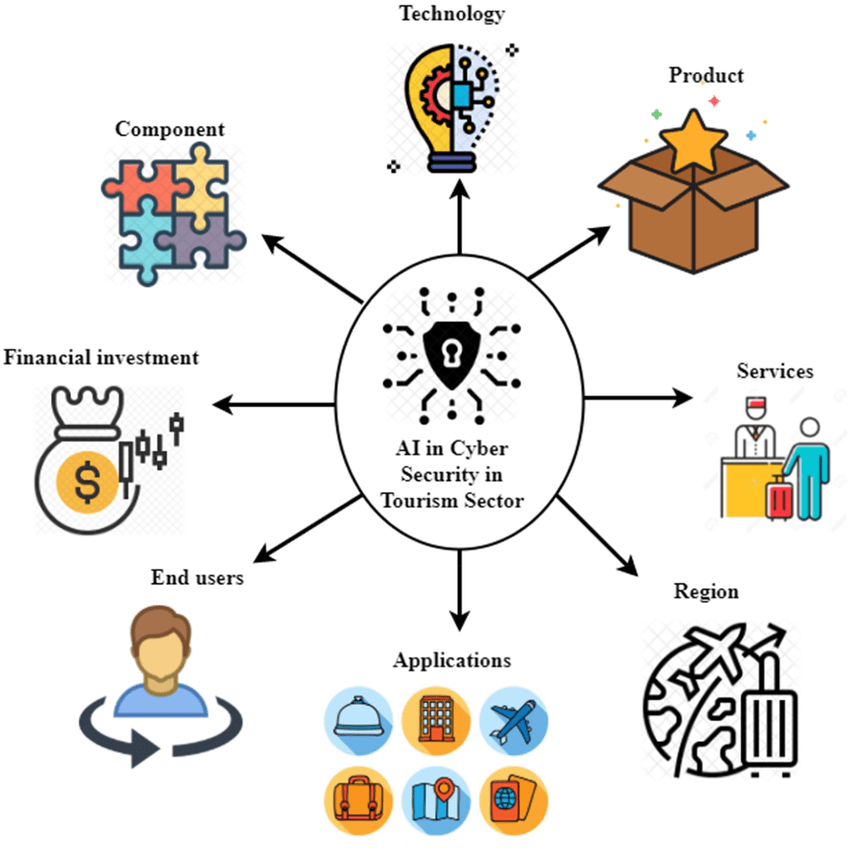
- Introduction
- Artificial Intelligence in Cybersecurity
- Benefits of AI in Cybersecurity
- AI-Powered Cyber Threats
- Challenges of AI in Cybersecurity
- Case Studies
- Future Trends
- Conclusion
Artificial Intelligence (AI) is revolutionizing cybersecurity by improving threat detection, risk assessment, and incident response. As cyber threats become more sophisticated, AI-driven security solutions provide organizations with the ability to predict, identify, and neutralize potential risks in real time.AI in cybersecurity plays a crucial role in detecting anomalies, analyzing large datasets, and automating threat mitigation processes. By leveraging machine learning and advanced analytics, AI enhances security strategies, making them more adaptive and resilient against evolving cyber threats. This article explores the significance of AI in Cybersecurity Training Courses, its applications, and how organizations can integrate AI-powered solutions to strengthen their security posture. We will discuss key areas where AI contributes to cyber defense, including threat intelligence, behavior-based detection, and automated security operations.
Want to learn more about Cybersecurity ? Enroll in our Complete Cyber Security Online Training Online!
Introduction
Cybersecurity is one of the most critical concerns in today’s hyper-connected world. With the increasing volume and sophistication of cyberattacks, organizations are facing threats from multiple vectors, including data breaches, ransomware, and advanced persistent threats (APTs). Traditional security methods, such as firewalls, antivirus software, and intrusion detection systems, have proven to be insufficient in defending against modern, rapidly evolving threats. This is where Artificial Intelligence (AI) comes into play. AI has the potential to transform cybersecurity by automating complex tasks, improving threat detection, and offering more efficient responses to security incidents. This section will introduce the growing need for robust cybersecurity systems and explore how AI in Cybersecurity is becoming an essential tool in combating these ever-evolving cyber threats. Additionally, we will cover various AI-driven cybersecurity methodologies, best practices, and cutting-edge tools that help safeguard sensitive information and critical infrastructure. AI’s ability to recognize patterns and predict potential attacks allows businesses to respond proactively, minimizing risks before they escalate.
Artificial Intelligence in Cybersecurity
Artificial intelligence in cybersecurity involves using AI technologies, such as machine learning, neural networks, and natural language processing, to improve the detection, prevention, and mitigation of cyber threats. AI can analyze vast amounts of data in real time, which allows it to identify patterns and anomalies that may indicate malicious activity. For example, machine learning algorithms can be trained to recognize normal network traffic and identify unusual behavior that could signal a cyberattack. Additionally, AI can be used to predict and preemptively address vulnerabilities by continuously monitoring systems for weaknesses.

In cybersecurity, AI applications range from threat detection to automating responses and even assisting in decision-making processes during incidents. By implementing AI-powered cybersecurity measures, organizations can enhance their resilience against phishing attacks, malware, Ransomware in Cybersecurity, and insider threats. AI not only improves response times but also reduces human errors, ensuring a robust and dynamic defense mechanism. As cyber threats continue to evolve, integrating AI into cybersecurity frameworks becomes essential. Stay ahead in the digital security landscape by understanding how AI transforms cybersecurity and enables smarter, more efficient threat protection. This section will explore the different AI techniques used in cybersecurity and discuss how these technologies enhance the overall security posture of organizations.
Enroll in ACTE’S Cyber Security Online Training if you want to become an expert in cyber security field and have a prosperous career.
Benefits of AI in Cybersecurity
The integration of AI in cybersecurity brings several substantial benefits, which make it an indispensable tool for organizations.
- Real-Time Threat Detection and Prevention: Traditional cybersecurity systems often rely on predefined rules or signatures to detect threats, which can be ineffective against new, unknown attacks. AI, on the other hand, uses machine learning to analyze and learn from patterns, enabling it to identify previously unseen threats. This allows organizations to detect attacks in real time, often before they can cause significant damage.
- Automated Responses to Cyber Threats: One of AI’s most compelling advantages is its ability to automate the response to threats. When a potential threat is detected, AI systems can initiate predefined countermeasures, such as blocking malicious IP Subnets , quarantining suspicious files, or isolating compromised devices. By automating these actions, AI reduces response time, minimizes human error, and ensures a faster reaction to emerging threats.
- Enhanced Incident Response: Speed and accuracy are essential in the event of a cyberattack. AI can help streamline incident response by analyzing data from various sources, identifying the scope of the attack, and providing security teams with actionable insights. AI can also assist in forensics, helping organizations understand the root cause of an attack and preventing future incidents.
- Improved Vulnerability Management: AI can continuously scan systems for vulnerabilities and weaknesses that attackers may exploit. By identifying these vulnerabilities before they are targeted, AI helps organizations proactively patch systems and reduce the risk of an attack. Moreover, AI-driven predictive analytics can forecast emerging vulnerabilities, allowing companies to stay ahead of cybercriminals.
Transform Your Career with Cyber Security Knowledge Enroll in ACTE’s Cyber Security Expert Masters Program Training Course Today!
AI-Powered Cyber Threats
While AI offers immense benefits in defending against cyberattacks, cybercriminals are also weaponizing it to carry out more sophisticated attacks. Cybersecurity Training Courses are increasingly using AI to create adaptive malware that can learn and evolve in real time to evade detection. For example, AI-powered malware can analyze its environment and change its behavior to avoid triggering security alarms. Similarly, AI is being used in phishing attacks to craft highly personalized and convincing messages, making it harder for individuals to distinguish between legitimate and malicious emails. Hackers are also using AI to automate and scale their attacks. AI can be used to conduct large-scale bot attacks, automate data scraping, or develop intelligent tools for exploiting vulnerabilities. These attacks are often faster, more efficient, and harder to detect than traditional methods, posing a significant challenge for cybersecurity defenders. To defend against AI-powered cyber threats, cybersecurity professionals must develop counter-AI strategies. This includes using AI-based detection systems, which are specifically designed to identify and mitigate AI-driven attacks. By leveraging AI to combat AI, organizations can stay one step ahead of cybercriminals and ensure their systems remain secure.
Challenges of AI in Cybersecurity
While AI offers numerous advantages, its implementation in cybersecurity is not without challenges.
- Dependence on Data Quality: AI’s effectiveness in cybersecurity relies heavily on the quality of data it processes. Poor or insufficient data can lead to inaccurate predictions and flawed decision-making. AI systems require large volumes of high-quality data to function effectively, and without this, their ability to detect threats may be compromised.
- False Positives and Negatives: One of the most significant challenges with AI in cybersecurity is managing the trade-off between false positives (incorrectly identifying normal behavior as Malware Analysis) and false negatives (failing to detect real threats). AI systems must be finely tuned to ensure that they can detect real threats without overwhelming security teams with false alerts.
- Ethical and Privacy Concerns: As AI is increasingly used in surveillance and monitoring, it raises ethical and privacy concerns. AI systems can track user behavior, which may lead to privacy violations if not carefully regulated. Additionally, biases in AI algorithms can lead to unfair or discriminatory outcomes, such as targeting specific individuals or groups unjustly.
- Integration with Existing Systems: Many organizations already have established cybersecurity systems, and integrating AI into these systems can be complex. Compatibility issues, technical challenges, and the need for staff retraining can slow down the adoption process. Organizations must invest time and resources to ensure that AI systems are seamlessly integrated into their existing infrastructure.
Preparing for Cyber Security job interviews? Check out our Cyber Security Interview Questions and Answers now!
Case Studies
Real-world examples provide a clear picture of how AI is being implemented in cybersecurity. Numerous organizations are already reaping the benefits of AI-powered cybersecurity solutions. For example, large corporations in the banking sector have deployed AI-driven threat detection systems to identify and prevent financial fraud. Similarly, cloud service providers use AI to monitor network traffic for signs of data breaches and other anomalies, significantly reducing their vulnerability to attacks. While AI has proven to be effective, there are instances where it has not lived up to expectations. For example, some organizations have faced difficulties in fine-tuning their AI systems, leading to false positives that overwhelmed security teams or missed critical threats. Analyzing these failures helps the industry learn what works and what doesn’t, ensuring continuous improvement in AI applications.

Future Trends
The future of AI in cybersecurity is promising, with several emerging trends that could further enhance the field.
- Quantum Computing: The rise of quantum computing presents both opportunities and challenges for AI and cybersecurity. Quantum computers could break current encryption methods, making it crucial for AI to adapt and evolve to address this threat. Quantum-safe encryption RSA Algorithm powered by AI may be the future of secure communication and data protection.
- Next-Generation AI Tools: Future AI tools in cybersecurity are expected to be more sophisticated, incorporating advanced deep learning techniques and autonomous decision-making capabilities. These tools will not only detect and respond to threats faster but will also provide more accurate predictions, helping organizations proactively address vulnerabilities before they are exploited.
- Collaborative Defense: As cyber threats become more complex, the future of cybersecurity will likely involve greater collaboration between AI-powered systems, security professionals, and even governments. AI could play a pivotal role in creating a unified global defense system where different organizations share threat intelligence in real-time, enabling faster and more effective responses to cyberattacks.
Conclusion
AI is undoubtedly transforming the cybersecurity landscape, offering unprecedented benefits in the detection, prevention, and response to cyber threats. However, as with any new technology, Cybersecurity Training brings its own set of challenges that must be carefully managed. Integrating AI into cybersecurity systems is a process that requires continuous learning, adaptation, and vigilance. As technology continues to evolve, organizations must stay ahead of emerging threats by adopting AI-powered tools and strategies that offer the best possible defense against an increasingly dangerous cyber threat environment. AI-driven security systems must be constantly updated to counter new and sophisticated cyberattacks. Organizations should implement strict ethical guidelines to prevent AI misuse in cybersecurity applications. A well-balanced approach, combining AI capabilities with human expertise, ensures optimal protection against cyber threats.





